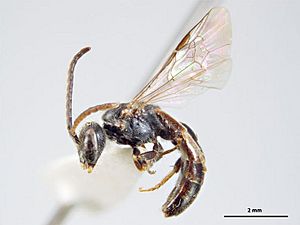Lasioglossum sordidum facts for kids
Quick facts for kids Lasioglossum sordidum |
|
|---|---|
 |
|
| Scientific classification | |
| Genus: |
Lasioglossum
|
| Species: |
sordidum
|
The Lasioglossum sordidum, also known as the small native bee, is one of the tiniest native bees found in New Zealand. These bees are very important for pollinating many plants across the country.
Contents
About the Small Native Bee
These bees are quite small, usually around 5 mm long. Even though they are tiny, their wings are quite large compared to their body size. They have a good amount of hair covering most of their body. People sometimes describe them as looking a bit like flies because they are small and quick.
Small native bees have short tongues. However, this doesn't stop them from collecting pollen. Female bees have wider bodies than the males. They look similar to honey bees in color and shape, but the small native bee is not as chunky. Because they are so small and fly-like, people often mistake them for flies or don't notice them at all.
Where Small Native Bees Live
Global Home of Lasioglossum sordidum
The Lasioglossum sordidum bee is special because it is found only in New Zealand. This means it is endemic to New Zealand.
Finding Them in New Zealand
You can find the small native bee all over New Zealand. It is one of the most common bees that builds its nests in the ground. The east coast of the South Island has the highest number of these adult native bees. They are even known to live in the Christchurch Botanic Gardens. This is because the gardens have many different kinds of plants, both native and those brought from other places.
Where They Like to Live
The small native bee builds its nests in the ground. Their nests are made of many tunnels that can go down as far as 400 mm (about 16 inches) below the surface. They prefer fine-grained soils for building their homes. In just a few square meters of bare soil, you might find hundreds of female bees nesting together.
These bees can fly quite far from their nests to find pollen. Female Lasioglossum sordidum bees are mostly solitary, meaning they work alone. However, many females might forage from the same nest. Also, several generations of bees can be active at the same time. This suggests they have some limited social organization, even if they are not fully social like honey bees.
Life Cycle of the Small Native Bee
During winter, female bees that have been fertilized stay inside their nests. They come out in late winter when the ground starts to get warmer. In the winter, young bees (called prepupae) stay in moist soil to survive the cold. New male and female bees start to appear in late spring and early summer. They are active during the warmer months. An individual bee usually lives for no longer than eight weeks. Because they spend a long time nesting, they collect food from many different flowering plants.
The Lasioglossum sordidum bees have a life cycle that includes both young and adult bees living together. This system helps them raise their young. While they are mostly solitary, females do share a single nest for foraging.
What They Eat and How They Find Food
Lasioglossum sordidum bees fly long distances to find food. They collect pollen and nectar from both native New Zealand plants and plants brought from other countries. They have been seen feeding on Discaria toumatou flowers. Female bees especially like introduced legumes (like clover) and composite flowers (like daisies).
Because they nest for a long time, they need to travel far to find enough food. These bees will visit almost any flower that is yellow or orange. They visit a wide variety of flowering plants. Bees in the family Asteraceae (like sunflowers and daisies) are often visited by Lasioglossum sordidum. They also forage on Hebe (plant). Female bees have been seen visiting 139 different plant species from 56 families. This shows they can find food from almost any flowering plant if they can get nectar or pollen from it. Lasioglossum sordidum bees are called polylactic. This means they can collect pollen from many different kinds of plants, even if they are not related.
Other Interesting Facts
Lasioglossum sordidum bees have been found visiting Kiwifruit flowers. They can carry over half a million male pollen grains. This is about the same amount as a bumble bee! This shows they are good at helping kiwifruit plants grow.
These bees are sometimes nicknamed "sweat bees." This is because human sweat can attract them.
Some bees within the Lasioglossum group are known as kleptoparasites. This means that a female bee might take over another bee's nest. She might lay her own egg in the cell and her egg will then eat the food stored by the host bee.
Native bees, like the Lasioglossum sordidum, are very important for pollinating many native plants in New Zealand. Before humans arrived, New Zealand did not have many pollinators with long tongues. However, it still had many native species that fed on nectar and pollen, and Lasioglossum sordidum was one of them.

